|
|
|
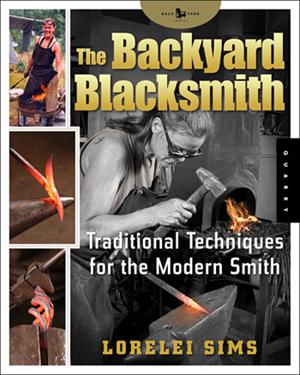
|
Lorelei Sims
The Backyard
Blacksmith
Traditional Techniques
for the Modern Smith
176 Pages, B&W and color size 8-1/8 x 10-1/4"
|
Book Review by Jock Dempsey and Sandra Wilson
First, I must apologize for not reviewing this book sooner.
Among the reasons. . we had to buy the book (most industry reviewers are sent a copy by the author or publisher),
I did not think the blacksmithing world needed yet ANOTHER basic book on blacksmithing, and last fairness,
I tried several times to get others to review the book without success (to avoid MY preconception that the world did not need another beginners book).
All this on top of the fact that I am quite delinquent in reviewing a number of books.
My most humble apologies to Lorelei.
There are few female smiths. There are fewer women writing about blacksmithing.
This makes a book about blacksmithing written by a female smith quite a rare thing.
It is also quite a good book.
Fully Illustrated
To start, the photos and illustrations are quite good and better than most.
Almost every page has one or more photos or drawings.
Professionals were hired and they did a professional job.
There are none of the illustration faults typically found in new books.
All the illustrations are nicely drawn, clear and reproduced well.
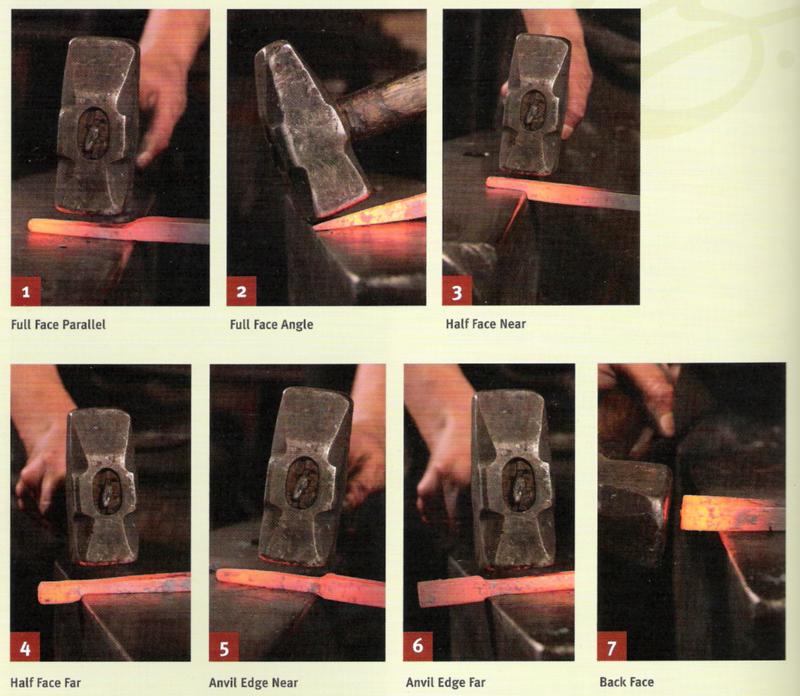
The photographs are all well composed, focused and cropped.
The only issue I have with them is that they were taken in a blacksmith shop, with shop lighting and shop backgrounds.
In other words, the worst location you can think of.
In many cases I would have cut out backgrounds to make the subject stand out better.
But this is a matter of taste and book design.
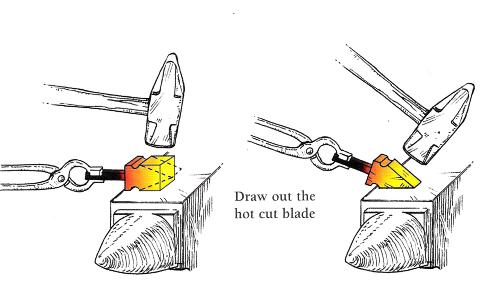
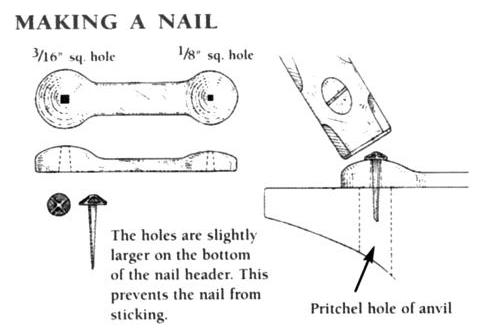
Backyard Content
The title of this book is a misnomer.
There is no "backyard" to this book. No primitive pit forges, no make do anvils, no home made scrap bellows.
This is a book about REAL shop tools and basic techniques which are both well covered.
Lorelei starts with discussing the necessary space and layout of a shop.
She then proceeds to safety and first aid, THEN tools in fair detail.
The knowledge she passes on is from years of experience as well as having worked with many others.
Throughout the book there are side bar tips titled "Tricks of the Trade" and many step by step instructions for making various tools.
I can easily recommend this book as a getting started reference or a text book for a blacksmithing school.
Sandra Wilson's Review
This is a great beginners blacksmithing book.
It shows how to layout a shop, setup a coal forge, teaches about the different tools in blacksmithing, types of iron, and the skills needed to make projects large and small.
This is the first beginning blacksmithing book that I have read, although not the first I have looked at, but it has taught me the difference between a hot and cold cut hardy.
Since I am new to blacksmithing, I do not have many tools to call my own and what Lorelei does is show me how to make various jigs and hardies.
Which is awesome because... Well, I don't have any.
The twenty projects in this book allow one to practice the skills required and used by every smith, all while making beautiful and functional pieces of art (well, the ones in the book look pretty
good, but mine are... okay. Right now. I'll get better.)
The Backyard Blacksmith is wonderfully illustrated, the pictures are great quality, and unlike some of the blacksmith books I've seen, the few
line or CAD drawings within this book are actually nice drawings.
Anyway, I would recommend this book to any beginner blacksmith.. It is not the most comprehensive one that I have read, but it gives lots of
information without being overwhelming.
So yeah, fun book.
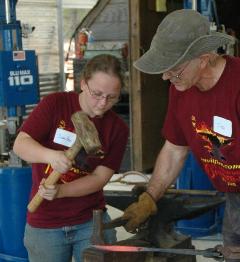
Sandy striking for Josh Greenwood
at anvilfire hammer-in 2008
|
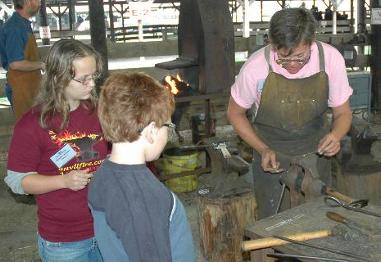
Sandy with Lorelei at SOFA 2008.
|
Author's Note: From her web site
It was recently brought to my attention that there is a stock size
measurement error in the current printing of the book. On page 134, the Wall
Mount Hook and Dinner Bell Project, the stock size for the Dinner Bell Triangle
should read 1/2" round stock. Although the project can be completed using
3/4" round stock, it is going to be somewhat difficult (though not impossible).
Please also note that on page 136, the suggested 1/8" stock material for the Camping
Pot Rack Hooks is smaller than the 3/16" hook material depicted in the photograph.
Although any stock size can be used, just make sure that the hook material can fit
through the hangers in your cookware and utensils.
Although the book (page 40) specifies that aluminum wire is used when
MIG welding, there are several different kinds of metal and alloy wire
spools that may be used in this process.
Published by: Quarry Books
BlacksmithChic.com Lorelie's web site
Published: 2006
ISBN 1-59253-251-9
$25.00
Available from the author and anvilfire.com advertisers.
|
|
|
The Backyard
Blacksmith
Traditional Techniques
for the Modern Smith
176 Pages, B&W and color size 8-1/8 x 10-1/4"
Book Review by Jock Dempsey and Sandra Wilson
First, I must apologize for not reviewing this book sooner. Among the reasons. . we had to buy the book (most industry reviewers are sent a copy by the author or publisher), I did not think the blacksmithing world needed yet ANOTHER basic book on blacksmithing, and last fairness, I tried several times to get others to review the book without success (to avoid MY preconception that the world did not need another beginners book). All this on top of the fact that I am quite delinquent in reviewing a number of books. My most humble apologies to Lorelei.There are few female smiths. There are fewer women writing about blacksmithing. This makes a book about blacksmithing written by a female smith quite a rare thing. It is also quite a good book.
Fully Illustrated
To start, the photos and illustrations are quite good and better than most. Almost every page has one or more photos or drawings. Professionals were hired and they did a professional job. There are none of the illustration faults typically found in new books. All the illustrations are nicely drawn, clear and reproduced well.The photographs are all well composed, focused and cropped. The only issue I have with them is that they were taken in a blacksmith shop, with shop lighting and shop backgrounds. In other words, the worst location you can think of. In many cases I would have cut out backgrounds to make the subject stand out better. But this is a matter of taste and book design.
Backyard Content
The title of this book is a misnomer. There is no "backyard" to this book. No primitive pit forges, no make do anvils, no home made scrap bellows. This is a book about REAL shop tools and basic techniques which are both well covered.Lorelei starts with discussing the necessary space and layout of a shop. She then proceeds to safety and first aid, THEN tools in fair detail. The knowledge she passes on is from years of experience as well as having worked with many others.
Throughout the book there are side bar tips titled "Tricks of the Trade" and many step by step instructions for making various tools.
I can easily recommend this book as a getting started reference or a text book for a blacksmithing school.
Sandra Wilson's Review
This is a great beginners blacksmithing book. It shows how to layout a shop, setup a coal forge, teaches about the different tools in blacksmithing, types of iron, and the skills needed to make projects large and small. This is the first beginning blacksmithing book that I have read, although not the first I have looked at, but it has taught me the difference between a hot and cold cut hardy.Since I am new to blacksmithing, I do not have many tools to call my own and what Lorelei does is show me how to make various jigs and hardies. Which is awesome because... Well, I don't have any. The twenty projects in this book allow one to practice the skills required and used by every smith, all while making beautiful and functional pieces of art (well, the ones in the book look pretty good, but mine are... okay. Right now. I'll get better.) The Backyard Blacksmith is wonderfully illustrated, the pictures are great quality, and unlike some of the blacksmith books I've seen, the few line or CAD drawings within this book are actually nice drawings. Anyway, I would recommend this book to any beginner blacksmith.. It is not the most comprehensive one that I have read, but it gives lots of information without being overwhelming. So yeah, fun book.
Sandy striking for Josh Greenwood
at anvilfire hammer-in 2008
Sandy with Lorelei at SOFA 2008.
Author's Note: From her web site
It was recently brought to my attention that there is a stock size measurement error in the current printing of the book. On page 134, the Wall Mount Hook and Dinner Bell Project, the stock size for the Dinner Bell Triangle should read 1/2" round stock. Although the project can be completed using 3/4" round stock, it is going to be somewhat difficult (though not impossible).Please also note that on page 136, the suggested 1/8" stock material for the Camping Pot Rack Hooks is smaller than the 3/16" hook material depicted in the photograph. Although any stock size can be used, just make sure that the hook material can fit through the hangers in your cookware and utensils.
Although the book (page 40) specifies that aluminum wire is used when MIG welding, there are several different kinds of metal and alloy wire spools that may be used in this process.
Published by: Quarry Books
BlacksmithChic.com Lorelie's web site
ISBN 1-59253-251-9
$25.00
Available from the author and anvilfire.com advertisers.